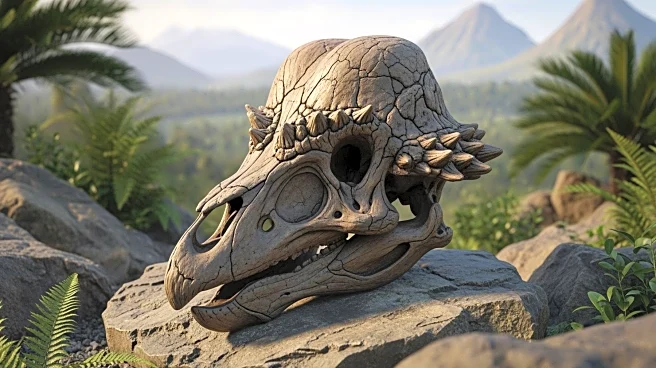What's Happening?
Paleontologist Chinzorig Tsogtbaatar, along with colleagues, discovered a new species of pachycephalosaur in southeast Mongolia. The species, named Zavacephale rinpoche, is notable for its dome-shaped skull, a characteristic feature of pachycephalosaurs.
This discovery is significant as it is the first definitive pachycephalosaur found from the early Cretaceous period, filling a critical gap in the evolutionary history of these dome-headed dinosaurs. The fossil, unearthed in 2019, was shipped to North Carolina for further analysis in 2022. The specimen is remarkably complete, providing new insights into the anatomy and lifestyle of pachycephalosaurs, including the presence of small stones in the stomach for digestion and rigid tail supported by bony tendons.
Why It's Important?
The discovery of Zavacephale rinpoche is crucial for understanding the early evolution of pachycephalosaurs, a group of dinosaurs known for their thick, bony skulls. This find provides paleontologists with a more complete picture of the anatomy and behavior of these dinosaurs, which were previously known from incomplete skeletons. The completeness of the fossil allows researchers to study features such as the dinosaur's hand bones and juvenile characteristics, offering insights into their development and social behavior. This discovery could lead to new theories about how pachycephalosaurs lived and interacted, potentially influencing future paleontological research and education.
What's Next?
The specimen has returned to the Institute of Paleontology of the Mongolian Academy of Sciences, where it will be preserved as part of Mongolia's efforts to protect its natural heritage. Researchers will continue to study the fossil to uncover more details about the lifestyle and evolution of pachycephalosaurs. The discovery is expected to inspire further paleontological expeditions in Mongolia and other regions, aiming to find more complete specimens that can shed light on the lives of these ancient creatures. Additionally, the findings may prompt revisions in the understanding of dinosaur evolution and behavior.
Beyond the Headlines
The discovery of Zavacephale rinpoche highlights the importance of international collaboration in paleontology, as researchers from Mongolia and the United States worked together to analyze the fossil. It also underscores the significance of preserving natural heritage, as the specimen's return to Mongolia reflects efforts to maintain cultural and scientific integrity. The find may influence ethical considerations in fossil excavation and the sharing of scientific knowledge across borders, promoting a more inclusive approach to paleontological research.
















